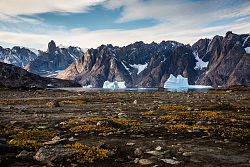

A study has shown, for the first time, that rock "flour" produced by the grinding under Greenland's glaciers can trap carbon dioxide when spread on farm fields.
Natural chemical reactions break down the rock powder and lead to CO2 from the air being fixed in new carbonate minerals.
Scientists believe measures to speed up this process, called enhance rock weathering (ERW), have global potential and could remove billions of tonnes of CO2 from the atmosphere, helping to prevent extreme global heating.
Soil fertility naturally depends on rock weathering to provide essential nutrients, so enhancing the process delivers an extra benefit. Spreading the Greenland rock flour on fields in Denmark, including those growing barley from the Carlsberg brewery, significantly increased yields.
Greenland's giant ice sheet produces one billion tonnes a year of rock flour, which flows as mud from under the glaciers. Researchers say this means the potential supply of rock flour could be unlimited, and removing some would have very little effect on the local environment.
The weathering process takes decades to complete, but researchers say ERW could make a meaningful difference in meeting the key target of net zero emissions by 2050.
Phasing out the burning of fossil fuels remains the most critical climate action, but most scientists agree that ways of removing CO2 from the atmosphere will also be needed to avoid the worst effects of the climate crisis.
Professor Minik Rosing, part of the research team at the University of Copenhagen, said: "Above all this is a scalable solution. Rock flour has been piling up in Greenland for the past 8,000 years or so. The whole Earth’s agricultural areas could be covered with this, if you wished".
Other researchers are investigating the use of mechanically ground rock for ERW, but Dr Christiana Dietzen, also from the University of Copenhagen, said: "unlike other sources, glacial rock flour does not need any processing".
The research on the CO2 uptake of Greenland rock flour estimated that 250kg of CO2 can be trapped per tonne of rock flour.
After three years in soil in Denmark, the researchers found about 8% of this had been achieved, and calculated that 27 million tonnes of CO2 could be captured if all farmland in Denmark was spread with the rock flour. That is an amount similar to the country's total annual CO2 emissions.
Other ERW research has used mechanically ground basalt and a 2020 study estimated that treating about half of global farmland with this could capture two billion tonnes of CO2 each year, equivalent to the combined emissions of Germany and Japan.
Professor David Beerling, who led the 2020 research at the University of Sheffield, said basalt had significant advantages as its chemical composition absorbs CO2 faster than glacial rock flour, may increase crop yields by more, and is widely available close to many farming areas.
Beerling said: "We need all the weapons we can muster in the fight against climate change and my sense is that glacial rock flour could be a useful one".
"But it is not a gamechanger".
Nevertheless, rock flour is much finer than the ground basalt and so exposes more surface area to weathering. The advantages and disadvantages of both types of rock dust are still being studied.
The Danish group is planning trials in Australia and assessing the energy requirements of shipping. Beerling's team expects to publish results of yield gains in corn following basalt application in the US in the near future.
Rosing, commenting on the news for Greenland, said: "It would be much nicer for the nation to be part of the [climate] solution, rather than just a symptom of the problem".
For more information on this subject, see: